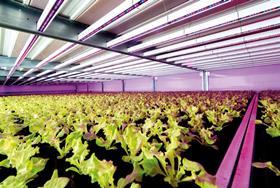
After years of success for original products like finger limes and seedless peppers, an innovation in production has won the prestigious Fruit Logistica Innovation Award for 2013.
In early February, Staay Food Group’s City Farming concept won a vote among the Berlin event’s 58,000 trade visitors, beating competition that included flower sprouts and ship-shaped apple slices.
The project controls light and temperature to enable Salanova and Salatrio lettuce root-balls to grow into young plants within 35 days. Working with Deliscious, a Beesel-based grower, and Philips Lighting from Eindhoven, Staay constructed a protective atmosphere that renders local climate and season irrelevant, and reduces exposure to diseases so that crop protection products are hardly needed.
Staay’s Hans de Groot tells Fruitnet.com: “Winning the award is confirmation that the food sector is very positive about City Farming. It offers promising opportunities which in the coming period must be developed further by the industry.”
Summit approach
The purple led lighting in the ‘climate chambers’ gives City Farming an ultramodern glow, but the principles of urban agriculture have deep roots. The world probably already has 800m urban farmers and, though data is sketchy, they could account for 20 per cent of global agricultural production. That’s what Food Tank’s Danielle Nierenberg told the entrepreneurs, policy makers and academics who convened in the southern Swedish town of Linköping for the second Urban Agriculture Summit on 29-31 January.
Organiser Plantagon, which is scheduled to start constructing the world’s first industrial-scale vertical greenhouse in Linköping this year, aimed to establish a research network for the development of similar projects that it believes can transform agricultural production in order to meet the food supply challenge: how to feed the world’s growing – and increasingly urban – population sustainably from shrinking areas of agricultural land.
Jan de Wilt, a keynote speaker from Innovatie Netwerk in the Netherlands, presented an idea for large-scale food production on industrial estates close to cities that he first came up with 13 years ago. In the aftermath of a “very stimulating” event, he is ready to renew the Agroparks project.
Middle way
‘Urban agriculture’ summons an array of images: from tiny allotments in the avant-garde neighbourhoods of East London to designs for colossal vertical farms that will never be built in New York. Nierenberg, De Wilt and the summit’s other speakers showed there is a plausible medium scale for such projects, that such projects already exist and that the fresh produce industry should take them seriously.
Persuading the fruit and vegetable establishment to engage might in part be a matter of branding. There is no need for euphemism here – this is not the chemicals industry renaming itself the ‘life sciences’ sector – but, as Tongji University’s Jan Staël von Holstein pointed out, the right brand can drive customer loyalty, which will be crucial to the success of food that is city born and bred.
Shoppers’ scepticism about the naturalness of urban produce is currently a commercial disincentive to research and develop the category. De Groot believes the food hygiene and safety benefits of controlled environments will force such concerns into the background, pointing out that artificial lighting has been used in agriculture for many years without backlash from end consumers.
Global interest
“Concepts are developing rapidly,” says De Wilt. “They are on the verge of introduction in cities all over the world.” In Linköping, panellists from Mumbai, New York, Shanghai, Singapore and Sweden discussed the issues peculiar to their urban farming projects.
Dickson Despommier, author of The Vertical Farm: Feeding the World in the 21st Century, pointed out that the city of New York uses 1bn gallons of water a day, eventually throwing all of it away.
“Stop thinking crazy; start thinking like nature,” implored the Columbia University professor. “Nature doesn’t throw anything away.” And neither would the ‘closed’ production systems analysed during the three days of the summit.
When Fruitnet.com last interviewed him at the start of 2012, Despommier highlighted six urban agriculture projects and said he’d be able to pick out 60 of them in a year’s time. And, indeed, “There are now over 50 in Japan alone,” he announced.
According to He Jie, an associate professor at Nanyang Technological University in Singapore, the tropical city-state requires government funding to research the cooling systems its vertical farms will need.
Mumbai is an “organic city”, said Shrikant Ramakrishnan. As such, it has no planned logistical infrastructure. A growing market for fresh, healthy food has caught the eye of private enterprises and urban farms could help overcome transport limitations.
Unlike the burgeoning cities of the developing world, Sweden’s building stock has a new-build rate of just 1 per cent a year. Instead of big urban-planning projects, Ulf Ranhagen, professor at the Royal Institute of Technology and chief architect at Sweco, suggested that fresh food production in this context was about “smaller-scale green renovations of existing projects”.
Practical action
Investment is the challenge common to all of them. Nierenberg was surprised there were not more practitioners in Linköping. “I think it’s important for urban farmers and food producers to attend and present the challenges they’re facing and the innovations they’re implementing in the field.”
The third Urban Agriculture Summit will return to Linköping at a similar time next year. Its organiser would do well to avoid a clash with Fruit Logistica 2014, because there are practitioners in Berlin too who are needed in Sweden to assess the viability of a sector that is establishing itself faster than they might imagine.



